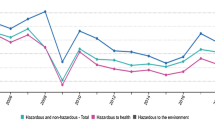Abstract.
In association with the international validation project to establish an OECD Enhanced Test Guideline 407, we performed a 28-day repeated-dose toxicity study of methoxychlor, a chlorinated hydrocarbon pesticide with pro-estrogenic and anti-androgenic activities. Attention was paid to the sensitivity of certain additional parameters for detecting endocrine related effects of endocrine disrupting chemicals based on the existing TG 407. Seven-week-old Crj:CD(SD)IGS rats were allocated to one of four groups, each consisting of ten males and ten females, and methoxychlor was administered once daily by gavage at doses of 0 (control), 20, 100 or 500 mg/kg body weight per day. Male rats were killed on the day after the 28th administration. Female rats were killed on the day of the diestrus stage during 4 days after the 28th administration. Male rats receiving methoxychlor showed mainly atrophy of mammary acinus in the 20 mg/kg and higher groups, together with decreases in prostate and seminal vesicle weights, and atrophy of epididymis, prostate, seminal vesicle and coagulating gland in the 100 and 500 mg/kg groups. In addition, decrease in serum testosterone level, increase in follicle-stimulating hormone level, decrease in testis and epididymis weights, atrophy of semiferous tubules and Leydig cells, decrease in the number of sperm in the caudal epididymis and their motility were observed in the 500 mg/kg group. Female rats receiving methoxychlor showed mainly abnormal estrous cycles, decrease in serum luteinizing hormone level, decrease in ovary weight, proliferation of mammary acinus, atrophy of ovary due to decrease in follicles and corpus luteum in histopathology, hypertrophy of endometrial epithelium of uterus and vagina epithelium in the 100 and 500 mg/kg groups. Among the parameters tested in the present experimental system, effects of methoxychlor on endocrine-related organs were detected with regard to serum hormone, organ weights, histopathological examination in both sexes, estrus cycle in females and sperm examination in males. Based on these results, a no-observed-adverse-effect level (NOAEL) in the present study was estimated to be below 20 mg/kg per day. In particular, the adverse effects were effectively detected in organ weights of accessory sex organs and histopathological examination.
Similar content being viewed by others
Author information
Authors and Affiliations
Additional information
Electronic Publication
Rights and permissions
About this article
Cite this article
Okazaki, K., Okazaki, S., Nishimura, S. et al. A repeated 28-day oral dose toxicity study of methoxychlor in rats, based on the 'Enhanced OECD Test Guideline 407' for screening endocrine-disrupting chemicals. Arch Toxicol 75, 513–521 (2001). https://doi.org/10.1007/s002040100273
Received:
Accepted:
Issue Date:
DOI: https://doi.org/10.1007/s002040100273




